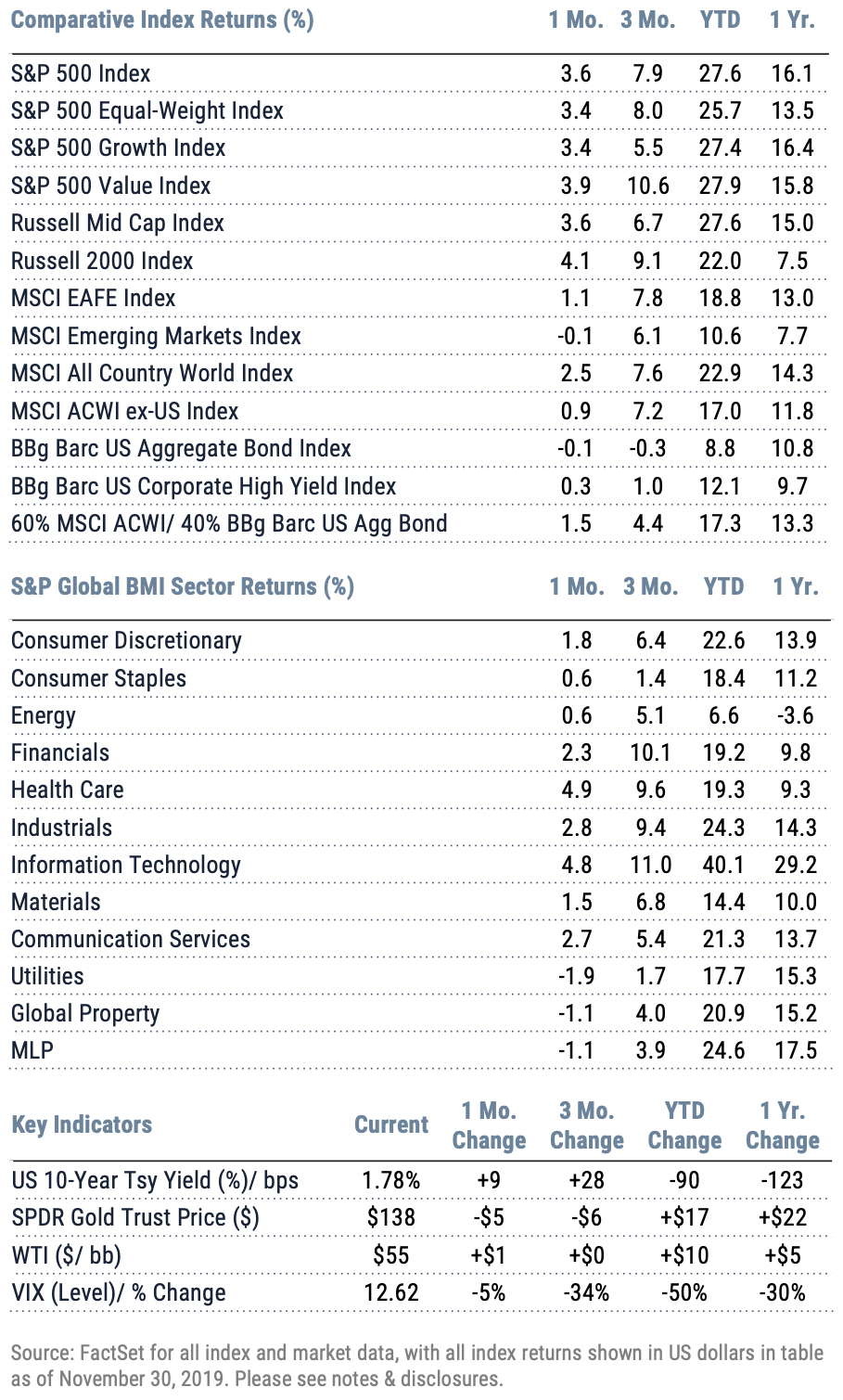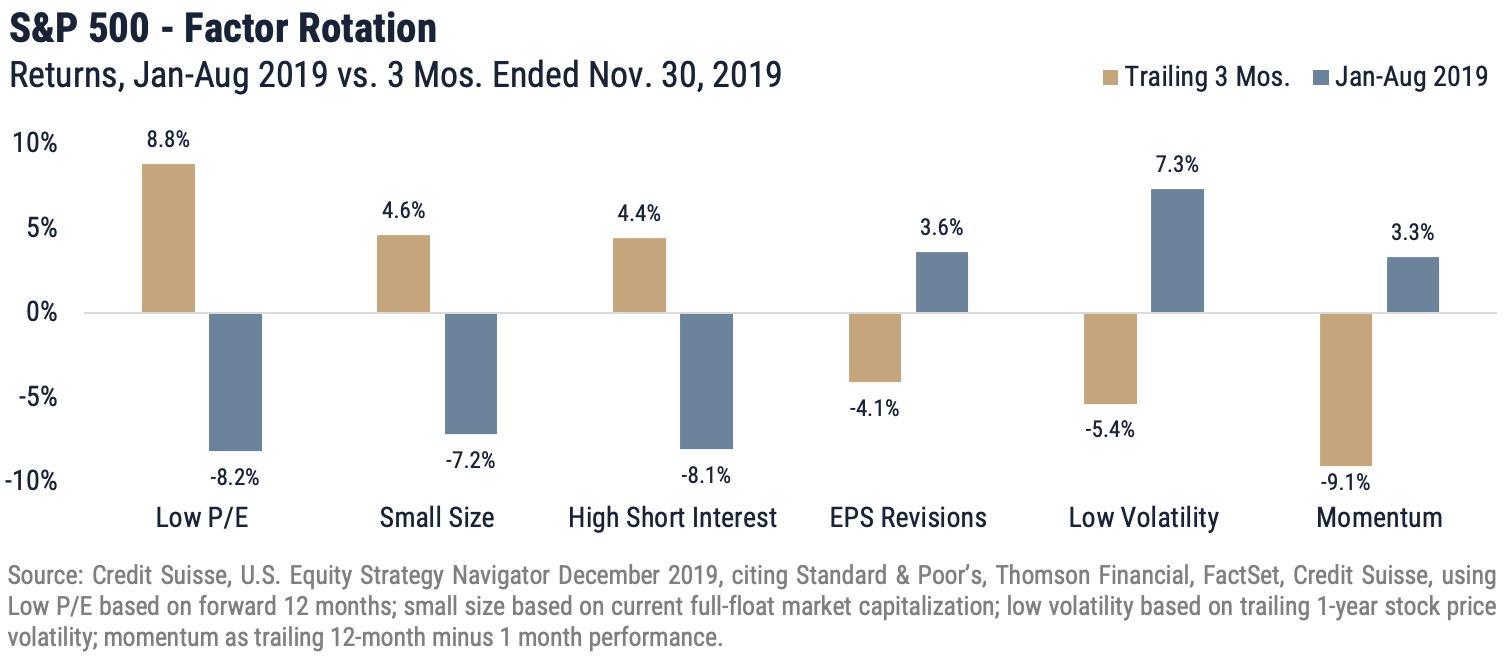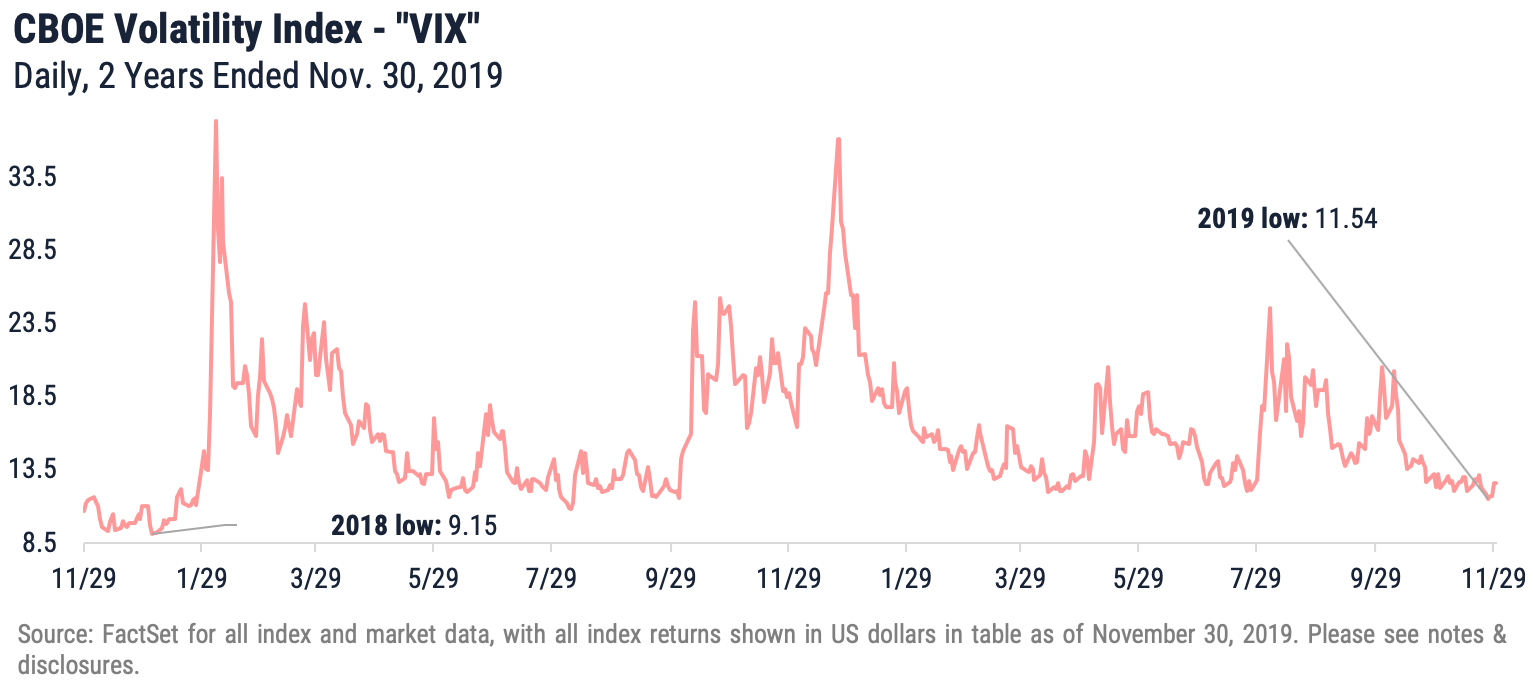November 2019 - Global Equity Market Review
4Q equity market momentum persisted in November, with global stocks adding 2.5% to round out a year-to-date return of nearly 23% in USD terms. US equities led as investors – thankful for constructive tones on trade and better-than-expected economic data – delivered fresh all-time highs for the S&P 500, Dow Jones Industrial Average and the tech-heavy NASDAQ. Global bond yields continued a modest rise as riskier assets garnered inflows, while the dollar strengthened modestly.

The S&P 500 added 3.6%, with the market-weight index outperforming equal-weight (+3.4%) even as within US equity broadly small-cap companies, as measured by the Russell 2000, posted a market-leading return of 4.1%. The S&P 500 Value gained 3.9%, deepening an apparent style rotation that, as shown in the first chart below, has over the last 90 days comprehensively reversed the fortunes of low P/E, low-momentum factors versus the first eight months of the year. Value edged ahead of growth for the year-to-date period but ceded the trailing 12-month performance advantage after holding it for September and October (September, notably, having broken a 29-month value losing streak on that basis).

As articulated in the underperformance of low-volatility names during this more recent, rotational period, volatility has charted a steady decline, with the VIX falling nearly 35% over the trailing 90 days and marking a 2019 low on November 26th. S&P 500 intra-day volatility (the spread between session high and low) collapsed and at 49 basis points was just 1 basis point higher than the lowest monthly level seen since November 2017.

Driven primarily by strength in the US, the MSCI ACWI Index advanced 2.5%; ex-US stocks added 0.9% in USD terms, with the impacts of dollar strengthening masking another 100 basis points of local currency return. Developed international equities added roughly 1.1% in USD (2.1% local), as Japan, Germany and the UK posted local returns in the 2% range. The pound rallied versus the Euro as the Bank of England left rates unchanged but fiscal stimulus was consensus rhetoric across parties in ongoing campaigns. Emerging equities were up around 60 basis points in local currency terms but shed 0.1% in USD for the month. While ongoing strife in Hong Kong casts a cloud over the region’s already softening economic prospects, China was buoyed by the same trade optimism as the US, gaining 1.7% in the context of an otherwise quiet emerging markets category. Excepting China and a 7.6% bounce in Turkey (just shy of sufficient to reverse the prior month’s politics-driven sell-off) emerging countries were either modestly negative or modestly positive in local terms.
With the exception of rate-sensitive Utilities and Real Estate, which posted losses around 170 basis points as bond yields rose, all equity sectors were positive. Technology and Health Care were up roughly 5% in the US and globally, while US Financials added 5% but saw a lesser move outside the US due to rate headwinds and currency impacts in Europe especially.
Notes & Disclosures
Index Returns – all shown in US dollars
All returns shown trailing 11/30/2019 for the period indicated. “YTD” refers to the total return as of prior-year end, while the other returns are annualized. 3-month and annualized returns are shown for:
- The S&P 500 index is comprised of large capitalized companies across many sectors and is generally regarded as representative of US stock market and is provided in this presentation in that regard only.
- The S&P 500® Equal Weight Index (EWI) is the equal-weight version of the widely-used S&P 500. The index includes the same constituents as the capitalization weighted S&P 500, but each company in the S&P 500 EWI is allocated a fixed weight - or 0.2% of the index total at each quarterly rebalance. The S&P 500 equal-weight index (S&P 500 EWI) series imposes equal weights on the index constituents included in the S&P 500 that are classified in the respective GICS® sector.
- The S&P 500 Growth Index is comprised of equities from the S&P 500 that exhibit strong growth characteristics and is weighted by market-capitalization.
- The S&P 500 Value Index is a market-capitalization weighted index comprising of equities from the S&P 500 that exhibit strong value characteristics such as book value to price ratio, cash flow to price ratio, sales to price ratio, and dividend yield.
- The Russell 3000 Index tracks the performance of 3000 U.S. corporations, determined by market-capitalization, and represents 98% of the investable equity market in the United States.
- The Russell Mid Cap Index measures the mid-cap segment performance of the U.S. equity market and is comprised of approximately 800 of the smallest securities based on current index membership and their market capitalization.
- The Russell 2000 Index is a market-capitalization weighted index that measures the performance of 2000 small-cap and mid-cap securities. The index was formulated to give investors an unbiased collection of the smallest tradable equities still meeting exchange listing requirements.
- The MSCI All Country World Index provides a measure of performance for the equity market throughout the world and is a free float-adjusted market capitalization weighted index.
- The MSCI EAFE Index is a market-capitalization weighted index and tracks the performance of small to large-cap equities in developed markets of Europe, Australasia, and the Far East.
- The MSCI Emerging Markets Index is a float-adjusted market-capitalization index that measures equity market performance in global emerging markets and cannot be purchased directly by investors.
- The S&P Global BMI sector indices are into sectors as defined by the widely used Global Industry Classification Standards (GICS) classifications. Each sector index comprises those companies included in the S&P Global BMI that are classified as members of respective GICS® sector. The S&P Global BMI Indices were introduced to provide a comprehensive benchmarking system for global equity investors. The S&P Global BMI is comprised of the S&P Emerging BMI and the S&P Developed BMI. It covers approximately 10,000 companies in 46 countries. To be considered for inclusion in the index, all listed stocks within the constituent country must have a float market capitalization of at least $100 million. For a country to be admitted, it must be politically stable and have legal property rights and procedures, among other criteria.
- The Barclay’s US Aggregate Index, a broad based unmanaged bond index that is generally considered to be representative of the performance of the investment grade, US dollar-denominated, fixed-rate taxable bond market.
- The Bloomberg Barclay’s US Corporate High Yield Index, which covers the USD-denominated, non-investment grade, fixed-rate, taxable corporate bond market.
Key Indicators
Key Indicators correspond to various macro-economic and rate-related data points that we consider impactful to equity markets.
- The US 10-Year Treasury Yield (%)/bps, is the return on investment for the U.S. government’s 10-year debt obligation and serves as a signal for investor confidence.
- SPDR Gold Trust Price ($), is an investment fund that reflects the performance on the price of a gold bullion, less the Trust’s expenses.
- West Texas Intermediate, which is an oil benchmark and the underlying asset in the New York Mercantile Exchange’s oil futures contract.
- CBOE Volatility Index (Level)/% Change, which uses price options on the S&P 500 to estimate the market's expectation of 30-day volatility.
This document is intended for informational purposes only and should not be otherwise disseminated to other third parties. Past performance or results should not be taken as an indication or guarantee of future performance or results, and no representation or warranty, express or implied is made regarding future performance or results. This document does not constitute an offer to sell, or a solicitation of an offer to purchase, any security, future or other financial instrument or product. This material is proprietary and being provided on a confidential basis, and may not be reproduced, transferred or distributed in any form without prior written permission from WST. WST reserves the right at any time and without notice to change, amend, or cease publication of the information. This material has been prepared solely for informative purposes. The information contained herein includes information that has been obtained from third party sources and has not been independently verified. It is made available on an "as is" basis without warranty and does not represent the performance of any specific investment strategy.
We consider an index to be a portfolio of securities whose composition and proportions are derived from a rules-based model. See the appropriate disclosures regarding models, indices and the related performance. You cannot invest directly in an index and the performance of an index does not represent the performance of any specific investment. Some of the information enclosed may represent opinions of WST and are subject to change from time to time and do not constitute a recommendation to purchase and sale any security nor to engage in any particular investment strategy.
Past performance or results should not be taken as an indication or guarantee of future performance or results, and no representation or warranty, express or implied is made regarding future performance or results.
Besides attributed information, this material is proprietary and may not be reproduced, transferred or distributed in any form without prior written permission from WST. WST reserves the right at any time and without notice to change, amend, or cease publication of the information. This material has been prepared solely for informative purposes. The information contained herein may include information that has been obtained from third party sources and has not been independently verified. It is made available on an “as is” basis without warranty. This document is intended for clients for informational purposes only and should not be otherwise disseminated to other third parties. Past performance or results should not be taken as an indication or guarantee of future performance or results, and no representation or warranty, express or implied is made regarding future performance or results. This document does not constitute an offer to sell, or a solicitation of an offer to purchase, any security, future or other financial instrument or product.
